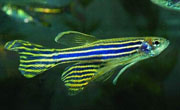


There’s a new way to explore biology’s secrets. With a flash of light, scientists from Berkeley Lab and UC Berkeley zeroed in on the type of neural cell that controls swimming in larval zebrafish. Using innovative light-activated proteins and gene expression techniques, the scientists zapped several zebrafish with a pulse of light, and initiated a swimming action in a subset of fish that was traced back to the neuron that drives the side-to-side motion of their tail fins. The technique behind this needle-in-haystack search for the neural roots of a specific behavior could become a powerful way to learn how biological systems work. More>
 Computing: ESnet Honored as One of Top 10 Government IT Innovators
Computing: ESnet Honored as One of Top 10 Government IT Innovators Once a year, InformationWeek magazine honors the most innovative players in the field of information technology, including the top 10 government agency innovators. And on Monday, the DOE's Energy Sciences Network (ESnet) was recognized as a member of this select group for its work helping thousands of researchers worldwide manage the massive amounts of scientific data stemming from the application of petascale supercomputers and high-precision instruments to cutting-edge disciplines such as climate science, high-energy physics, astrophysics and genomics. More>
Interim Lab Director Paul Alivisatos will conduct an all-hands meeting for employees today at noon in the Building 66 Auditorium. He will provide an update on the Lab’s strategic direction, management, safety efforts, and infrastructure initiatives, and will answer staff questions. For those unable to attend, the meeting will be webcast live, and later archived. The link will be activated at the start of the talk. Questions can be e-mailed to [email protected] during the broadcast, or sent now.
 Special Event: Lab Hosts Urban Heat Islands Conference
Special Event: Lab Hosts Urban Heat Islands ConferenceBerkeley Lab will host the International Conference on Countermeasures to Urban Heat Islands Sept. 21 to 23. Scientists from the Lab and around the world will present papers on the urban heat island effect and climate change, and how to mitigate both through such strategies as cool roofs, white roofs, solar reflective pavements and other cool materials, vegetation, advanced building design and urban planning. Government and utility policies to ameliorate hot cities and buildings will be discussed. More>
 [Atlantic Monthly] The epicenter of California’s energy revolution might justifiably be considered a roomy, dimly lit office in the bunker-like Energy Commission building in downtown Sacramento. There, behind a long conference table, surrounded by an untouched cup of chili and plates of apples, bananas, grapes, and tomatoes, sits Art Rosenfeld. In 1973, Rosenfeld was working as a particle physicist at Berkeley Lab. That September, the state legislature passed a bill creating a commission to manage California’s energy policy. Rosenfeld shifted his focus toward energy efficiency, organizing a working group (which eventually became the Center for Building Science) at the laboratory. "I thought," he told me dryly, "we had better do such things as learning how to turn out the lights." More>
[Atlantic Monthly] The epicenter of California’s energy revolution might justifiably be considered a roomy, dimly lit office in the bunker-like Energy Commission building in downtown Sacramento. There, behind a long conference table, surrounded by an untouched cup of chili and plates of apples, bananas, grapes, and tomatoes, sits Art Rosenfeld. In 1973, Rosenfeld was working as a particle physicist at Berkeley Lab. That September, the state legislature passed a bill creating a commission to manage California’s energy policy. Rosenfeld shifted his focus toward energy efficiency, organizing a working group (which eventually became the Center for Building Science) at the laboratory. "I thought," he told me dryly, "we had better do such things as learning how to turn out the lights." More>
 [Fresno Bee] A highly potent chemical capable of clearing farmland of pests, disease and weeds is attracting fierce opposition from environmental groups and some scientists in California. "We know that even in small amounts it can be very toxic," said Robert Bergman with Berkeley Lab’s Chemical Sciences Division and member of the National Academy of Sciences. "And in agriculture, you are talking about hundreds of pounds being put into the ground and covered with a tarp." More>
[Fresno Bee] A highly potent chemical capable of clearing farmland of pests, disease and weeds is attracting fierce opposition from environmental groups and some scientists in California. "We know that even in small amounts it can be very toxic," said Robert Bergman with Berkeley Lab’s Chemical Sciences Division and member of the National Academy of Sciences. "And in agriculture, you are talking about hundreds of pounds being put into the ground and covered with a tarp." More>
Tomorrow, a crane will be positioned on the Glaser Roadway in between Buildings 77 and 77A. This location will require a closure of the roadway from the stop sign located midway at Building 77 to the loading dock at the east end of Buildings 77 and 77A. Parking and traffic control measures will be in place and bus routes may be altered to accommodate the closure. The hours of operation for this lift are from 6 a.m. to approximately 4 p.m. For more information, contact Don Beaton (x7109).
Today at Berkeley Lab is produced by Public Affairs' Communications Department